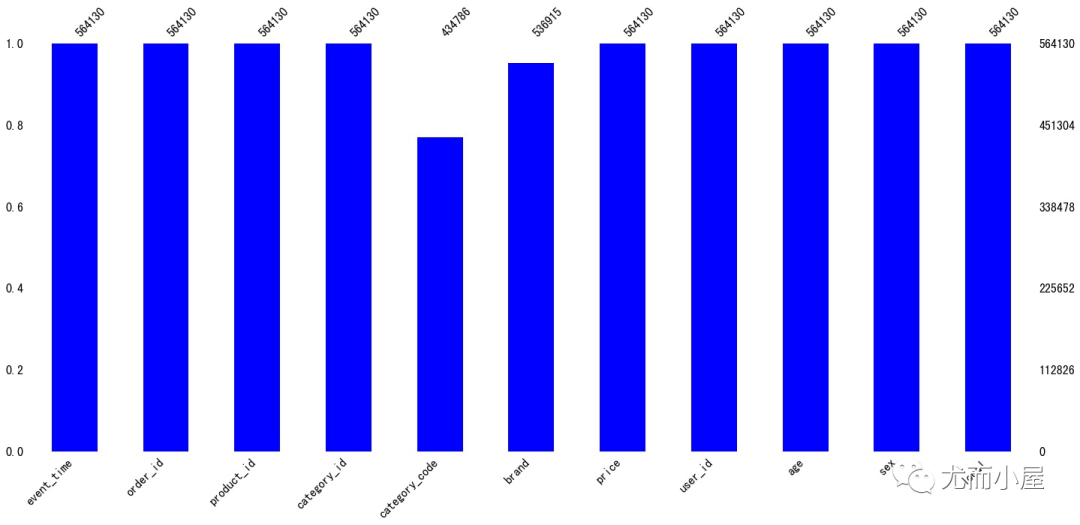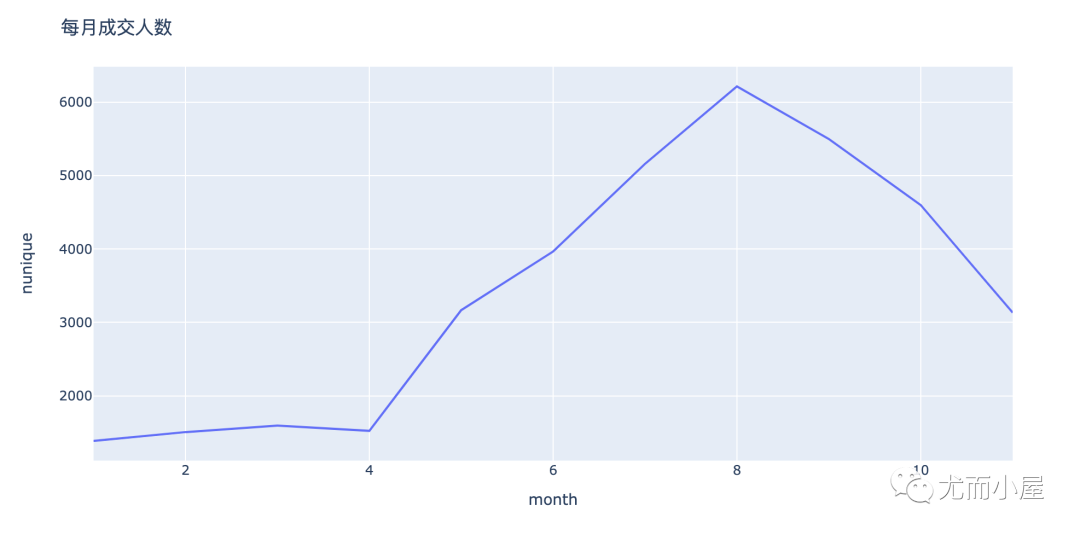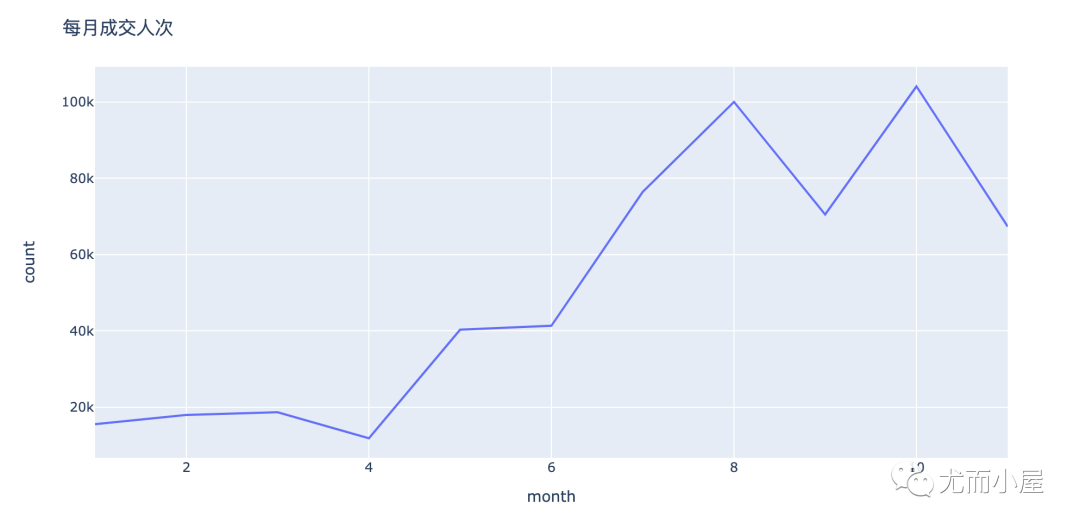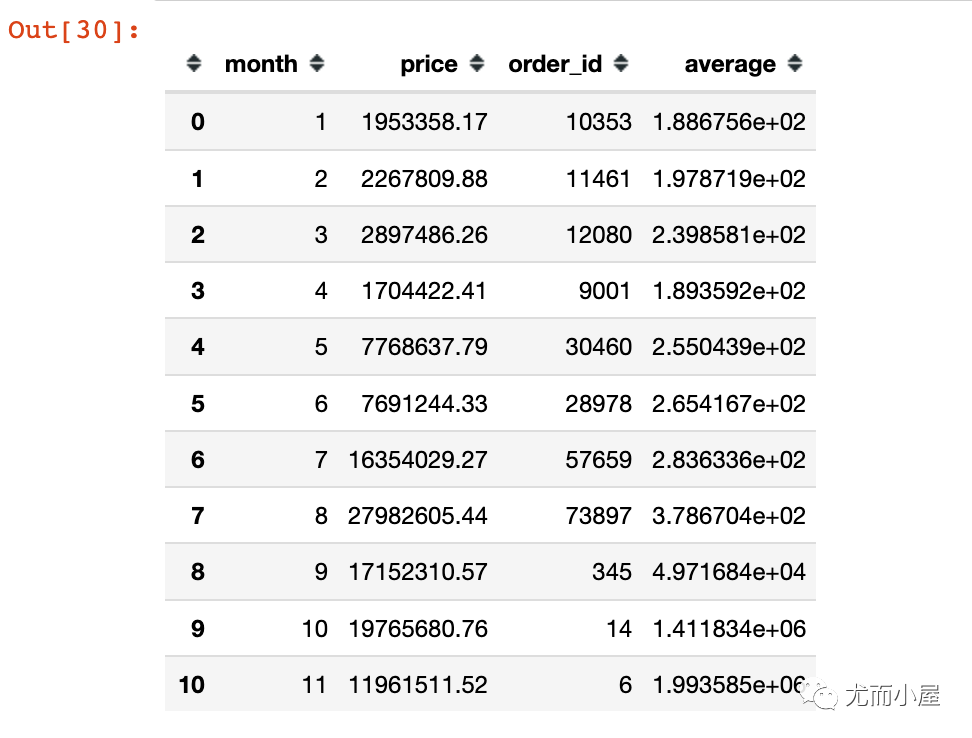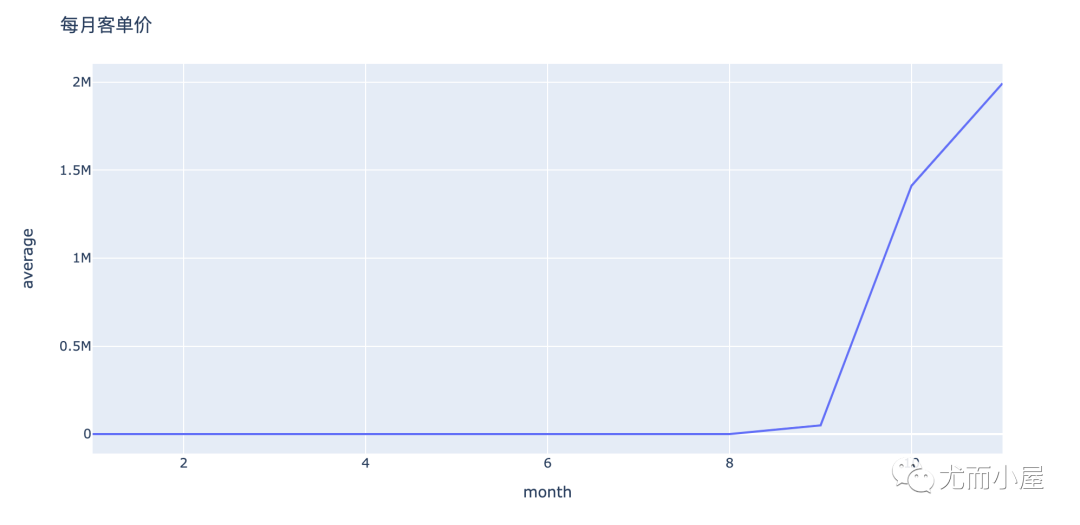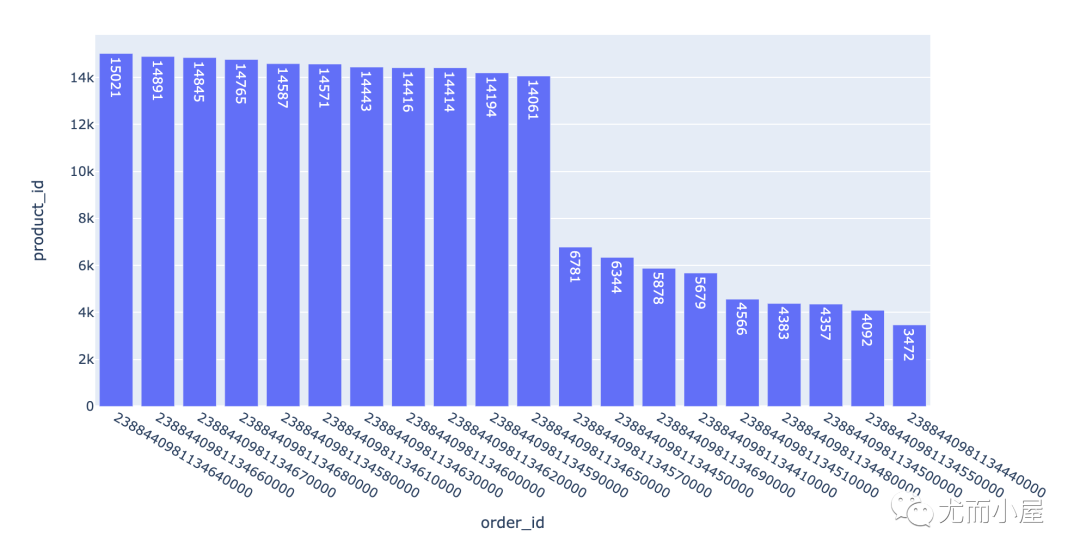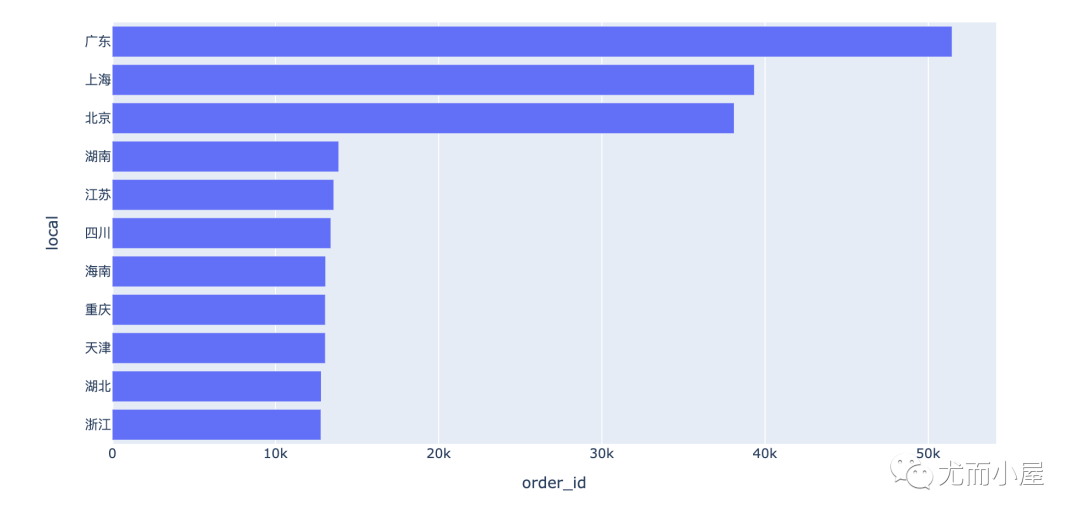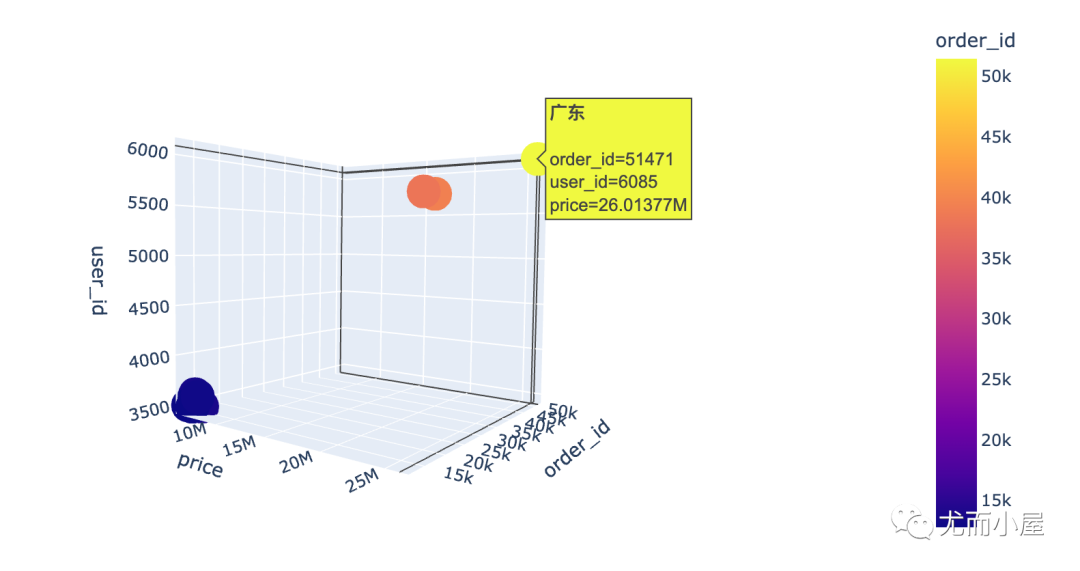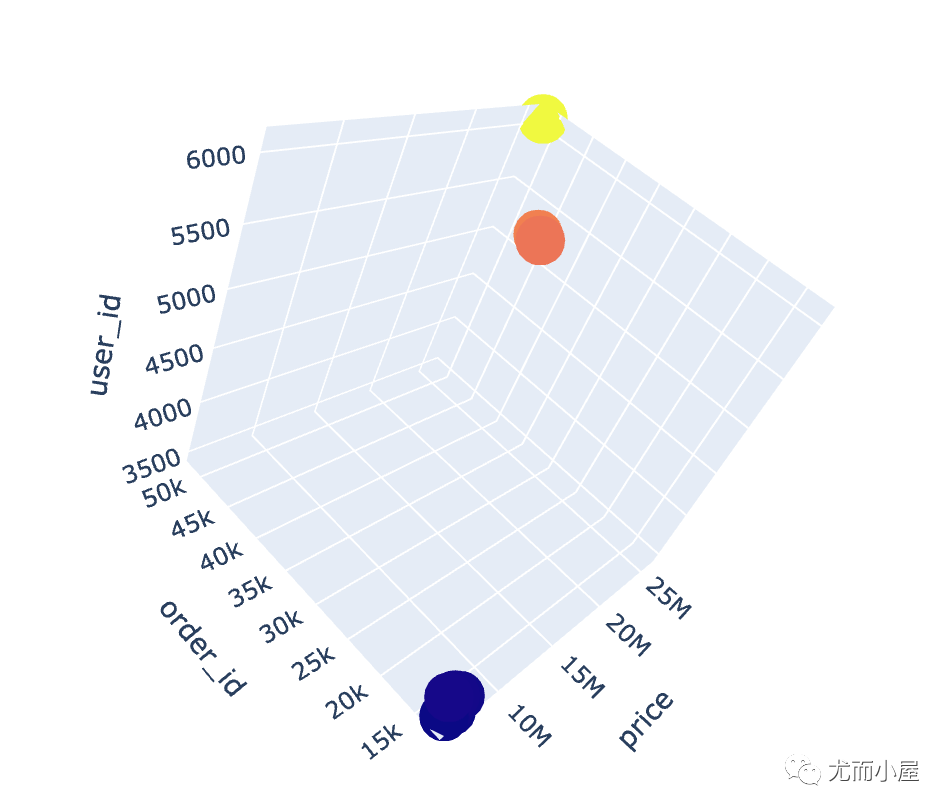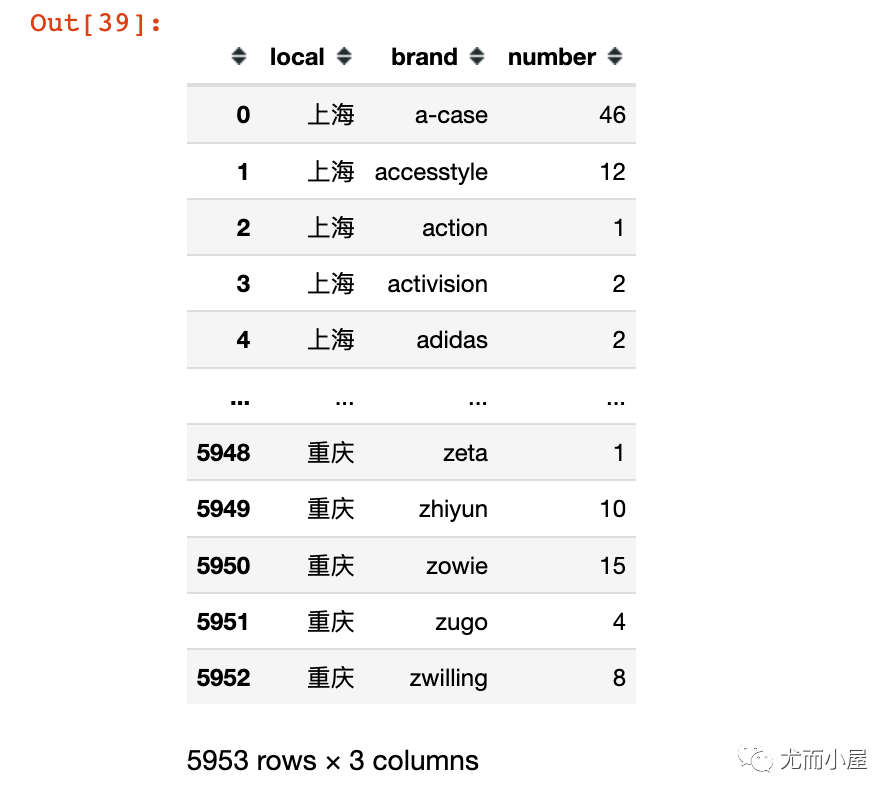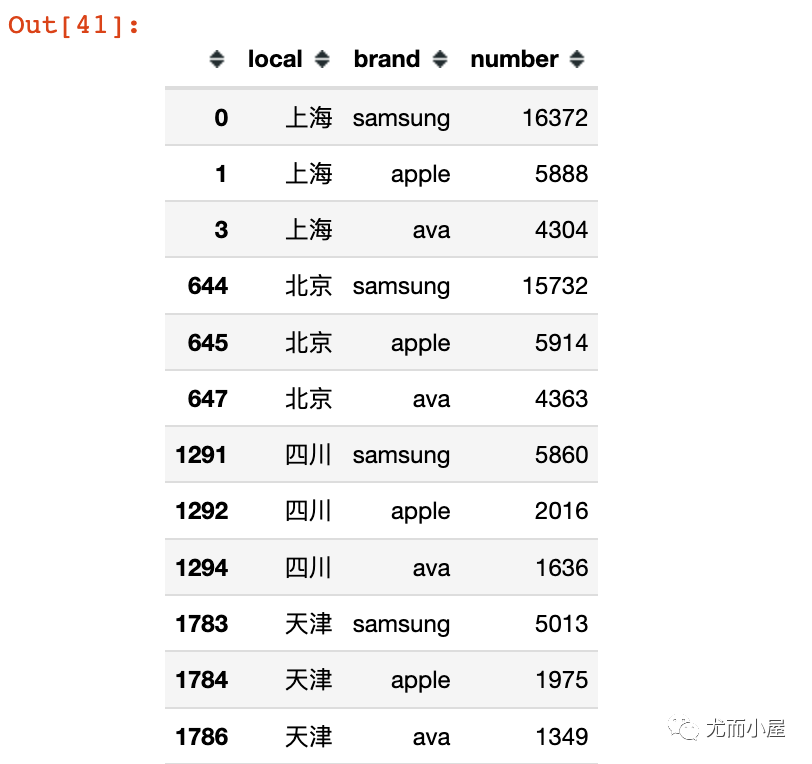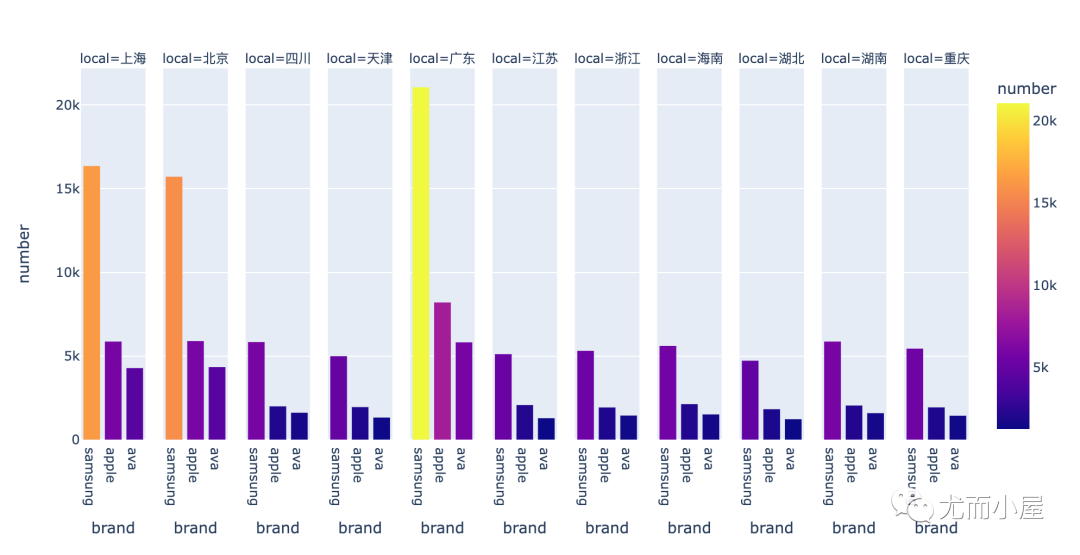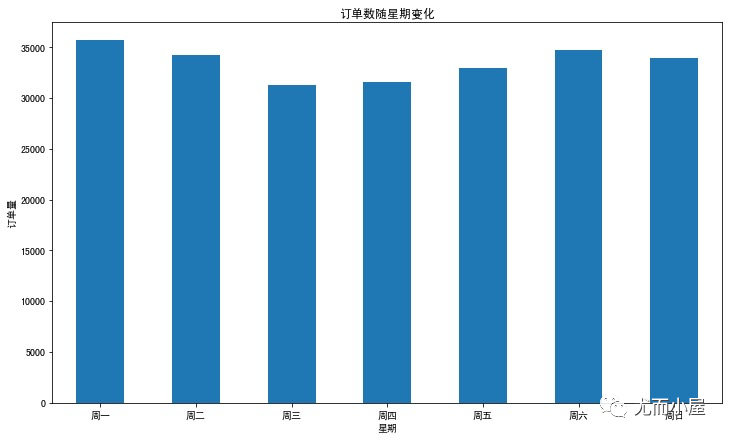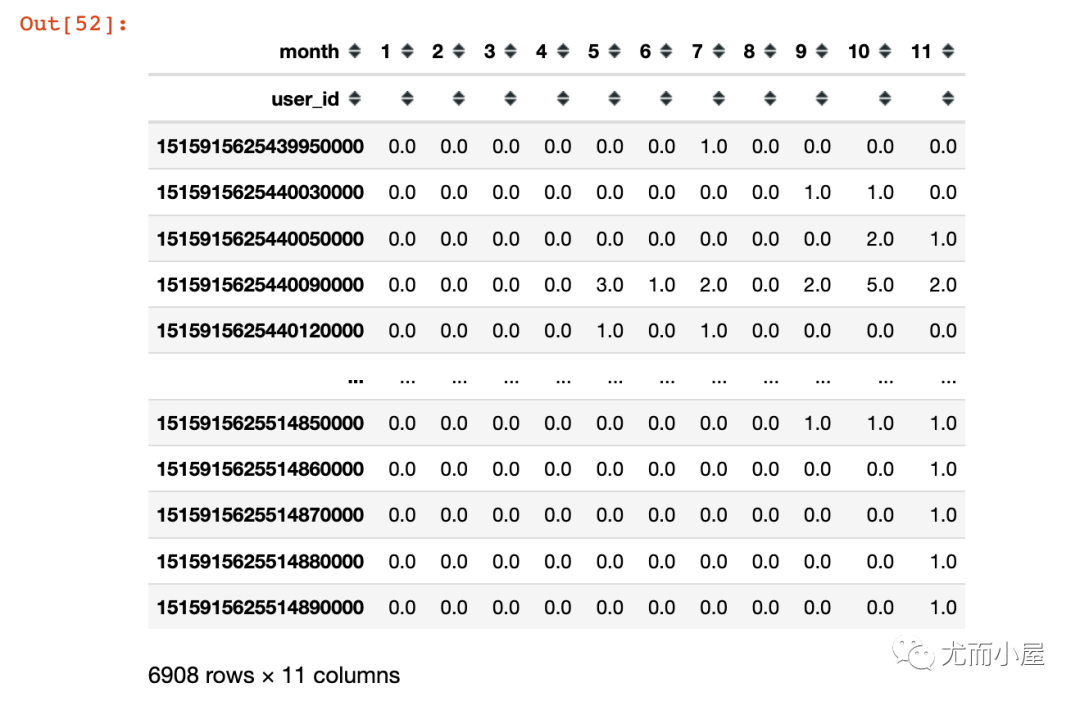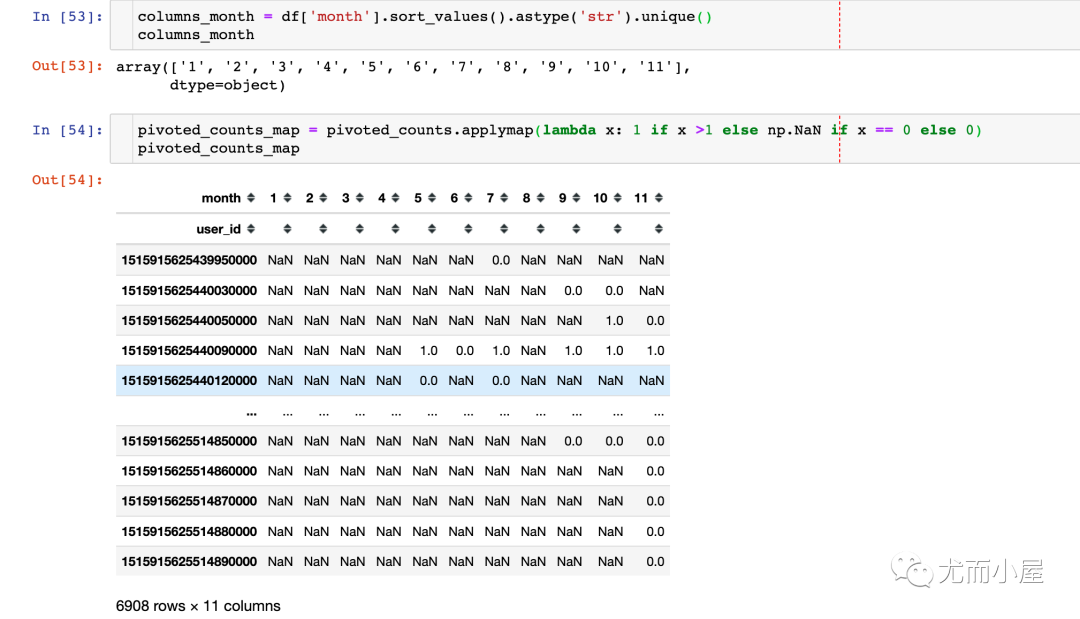converters参数的作用:数据中的多个id字段全部是数字,在csv或者excel文件中被当做了数字(用科学计数法表示);本质上它们就是"字符串"信息,不具备任何大小含义。
本文转载自微信公众号「尤而小屋」,作者尤而小屋 。转载本文请联系尤而小屋公众号。
大家好,我是Peter~
最近获取到了一份IC电子产品电商数据,后面会进行3个主题的数据分析与挖掘:
第一阶段:基于pandas、numpy、matplotlib、seaborn、plotly等库的统计可视化分析 第二阶段:基于机器学习聚类算法和RFM模型的用户画像分析 第三阶段:基于关联规则算法的品牌、产品和产品种类关联性挖掘 本文是第一个阶段,主要内容包含:
导入库 In [1]:
复制 import pandas as pd
import numpy as np
import time
import os
from datetime import datetime
import matplotlib.pyplot as plt
import seaborn as sns
% matplotlib inline
#设置中文编码和负号的正常显示
plt.rcParams [ 'font.sans-serif' ] = [ 'SimHei' ]
plt.rcParams [ 'axes.unicode_minus' ] = False
import plotly_express as px
import plotly.graph_objects as go
import missingno as ms
from sklearn.cluster import KMeans
from sklearn.preprocessing import MinMaxScaler1. 2. 3. 4. 5. 6. 7. 8. 9. 10. 11. 12. 13. 14. 15. 16. 17. 18. 19. 20. 数据基本信息 读取数据 复制 df = pd.read_csv (
"ic_sale.csv" ,
encoding= "utf-8" , # 指定编码
cnotallow= { "order_id" : str, "product_id" : str, "category_id" : str, "user_id" : str} # 指定字段类型
)
df.head ( ) converters参数的作用:数据中的多个id字段全部是数字,在csv或者excel文件中被当做了数字(用科学计数法表示);本质上它们就是"字符串"信息,不具备任何大小含义。读取的时候需要特意指定类型。
基本信息 读进来之后先查看数据的基本信息:
In [3]:
Out[3]:
In [4]:
Out[4]:
复制 event_time object
order_id object
product_id object
category_id object
category_code object
brand object
price float64
user_id object
age int64
sex object
local object
dtype: object1. 2. 3. 4. 5. 6. 7. 8. 9. 10. 11. 12. In [5]:
描述统计信息是针对数值型的字段:
复制 # 3 、数据描述统计信息
df.describe ( ) Out[5]:
price
age
count
564169.000000
564169.000000
mean
208.269324
33.184388
std
304.559875
10.122088
min
0.000000
16.000000
25%
23.130000
24.000000
50%
87.940000
33.000000
75%
277.750000
42.000000
max
18328.680000
50.000000
In [6]:
复制 # 4 、总共多少个不同客户
df[ "user_id" ] .nunique ( ) Out[6]:
In [7]:
复制 # 5 、总共多少个不同品牌
df[ "brand" ] .nunique ( ) Out[7]:
In [8]:
复制 # 6 、总共多少个订单
df[ "order_id" ] .nunique ( ) Out[8]:
In [9]:
复制 # 7 、总共多少个产品
df[ "product_id" ] .nunique ( ) Out[9]:
数据预处理 数据筛选 从描述统计信息中发现price字段的最小值是0,应该是没有成交的数据;我们选择price大于0的信息:
In [10]:
复制 df = df[df["price"] > 0]
缺失值处理 缺失值情况 In [11]:
Out[11]:
复制 event_time 0
order_id 0
product_id 0
category_id 0
category_code 129344
brand 27215
price 0
user_id 0
age 0
sex 0
local 0
dtype: int641. 2. 3. 4. 5. 6. 7. 8. 9. 10. 11. 12. 可以看到缺失值体现在字段:
In [12]:
复制 ms.bar ( df, color= "blue" ) # 缺失值可视化
plt.show ( )
缺失值填充 In [13]:
复制 df.fillna ( "missing" , inplace= True ) In [14]:
复制 df.isnull ( ) .sum ( ) # 填充之后无缺失值Out[14]:
复制 event_time 0
order_id 0
product_id 0
category_id 0
category_code 0
brand 0
price 0
user_id 0
age 0
sex 0
local 0
dtype: int641. 2. 3. 4. 5. 6. 7. 8. 9. 10. 11. 12. 时间字段处理 字段类型转化 读进来的数据中时间字段是object类型,需要将其转成时间格式的类型
In [15]:
复制 df[ "event_time" ] [ : 5 ] # 处理前Out[15]:
复制 0 2020 - 04 - 24 11 : 50 : 39 UTC
1 2020 - 04 - 24 11 : 50 : 39 UTC
2 2020 - 04 - 24 14 : 37 : 43 UTC
3 2020 - 04 - 24 14 : 37 : 43 UTC
4 2020 - 04 - 24 19 : 16 : 21 UTC
Name: event_time, dtype: objectIn [16]:
复制 # 去掉最后的UTC
df[ "event_time" ] = df[ "event_time" ] .apply ( lambda x: x[ : 19 ] ) In [17]:
复制 # 时间数据类型转化:字符类型---->指定时间格式
df[ 'event_time' ] = pd.to_datetime ( df[ 'event_time' ] , format= "%Y-%m-%d %H:%M:%S" ) 字段衍生 In [18]:
复制 # 提取多个时间相关字段
df[ 'month' ] = df[ 'event_time' ] .dt .month
df[ 'day' ] = df[ 'event_time' ] .dt .day
df[ 'dayofweek' ] = df[ 'event_time' ] .dt .dayofweek
df[ 'hour' ] = df[ 'event_time' ] .dt .hour In [19]:
复制 df[ "event_time" ] [ : 5 ] # 处理后Out[19]:
复制 0 2020 - 04 - 24 11 : 50 : 39
1 2020 - 04 - 24 11 : 50 : 39
2 2020 - 04 - 24 14 : 37 : 43
3 2020 - 04 - 24 14 : 37 : 43
4 2020 - 04 - 24 19 : 16 : 21
Name: event_time, dtype: datetime64[ ns] 可以看到字段类型已经发生了变化
整体趋势分析 分析1:每月成交金额多少? In [20]:
复制 amount_by_month = df.groupby ( "month" ) [ "price" ] .sum ( ) .reset_index ( )
amount_by_monthOut[20]:
month
price
0
1
1953358.17
1
2
2267809.88
2
3
2897486.26
3
4
1704422.41
4
5
7768637.79
5
6
7691244.33
6
7
16354029.27
7
8
27982605.44
8
9
17152310.57
9
10
19765680.76
10
11
11961511.52
In [21]:
复制 fig = px.scatter(amount_by_month,x="month",y="price",size="price",color="price")
fig.update_layout(height=500, width=1000, title_text="每月成交金额")
fig.show()
可以看到:
8月份是整个销售的顶峰 下半年的整体销售会好于下半年 分析2:月订单量如何变化? In [22]:
复制 order_by_month = df.groupby ( "month" ) [ "order_id" ] .nunique ( ) .reset_index ( )
order_by_monthOut[22]:
month
order_id
0
1
10353
1
2
11461
2
3
12080
3
4
9001
4
5
30460
5
6
28978
6
7
57659
7
8
73897
8
9
345
9
10
14
10
11
6
In [23]:
复制 fig = px.line ( order_by_month, x= "month" , y= "order_id" )
fig.update_layout ( height= 500 , width= 1000 , title_text= "每月成交订单量" )
fig.show ( )
关于订单量:
从1到8月份是一个逐渐上升的趋势;尤其是4到8月份;可能是五一假期或者暑假、开学季引起的 9、10月份订单量陡降:开学之后销量下降快 分析3:月消费人数/人次如何变化? In [24]:
复制 # nunique:对每个user_id进行去重:消费人数
# count :统计user_id 的次数;消费人次(存在一人多次购买)
people_by_month = df.groupby ( "month" ) [ "user_id" ] .agg ( [ "nunique" , "count" ] ) .reset_index ( )
people_by_monthOut[24]:
month
nunique
count
0
1
1388
15575
1
2
1508
17990
2
3
1597
18687
3
4
1525
11867
4
5
3168
40332
5
6
3966
41355
6
7
5159
76415
7
8
6213
100006
8
9
5497
70496
9
10
4597
104075
10
11
3134
67332
In [25]:
复制 fig = px.line ( people_by_month, x= "month" , y= "nunique" )
fig.update_layout ( height= 500 , width= 1000 , title_text= "每月成交人数" )
fig.show ( )
复制 fig = px.line ( people_by_month, x= "month" , y= "count" )
fig.update_layout ( height= 500 , width= 1000 , title_text= "每月成交人次" )
fig.show ( )
分析4:每月订单价多少? In [27]:
复制 amount_by_month # 每月成交金额Out[27]:
month
price
0
1
1953358.17
1
2
2267809.88
2
3
2897486.26
3
4
1704422.41
4
5
7768637.79
5
6
7691244.33
6
7
16354029.27
7
8
27982605.44
8
9
17152310.57
9
10
19765680.76
10
11
11961511.52
In [28]:
Out[28]:
month
order_id
0
1
10353
1
2
11461
2
3
12080
3
4
9001
4
5
30460
5
6
28978
6
7
57659
7
8
73897
8
9
345
9
10
14
10
11
6
In [29]:
复制 amount_by_userid = pd.merge ( amount_by_month, order_by_month)
amount_by_useridOut[29]:
month
price
order_id
0
1
1953358.17
10353
1
2
2267809.88
11461
2
3
2897486.26
12080
3
4
1704422.41
9001
4
5
7768637.79
30460
5
6
7691244.33
28978
6
7
16354029.27
57659
7
8
27982605.44
73897
8
9
17152310.57
345
9
10
19765680.76
14
10
11
11961511.52
6
In [30]:
复制 amount_by_userid[ "average" ] = amount_by_userid[ "price" ] / amount_by_userid[ "order_id" ]
amount_by_userid
复制 fig = px.line ( amount_by_userid, x= "month" , y= "average" )
fig.update_layout ( height= 500 , width= 1000 , title_text= "每月客单价" )
fig.show ( )
从上面的折线图可以看出来:
1到8月份月订单量基本持平;可能是有很多批量的订单;通过量大带来利润:量的路线 9到10月份:月单价急剧上升;订单量少,但是金额;可能存在大额消费的用户:质的路线 分析5:每个订单包含多少产品 In [32]:
复制 product_by_order = df.groupby ( "order_id" ) [ "product_id" ] .count ( ) .reset_index ( ) .sort_values ( "product_id" , ascending= False )
product_by_order.head ( 10 ) Out[32]:
order_id
product_id
234208
2388440981134640000
15021
234210
2388440981134660000
14891
234211
2388440981134670000
14845
234212
2388440981134680000
14765
234202
2388440981134580000
14587
234205
2388440981134610000
14571
234207
2388440981134630000
14443
234204
2388440981134600000
14416
234206
2388440981134620000
14414
234203
2388440981134590000
14194
In [33]:
复制 fig = px.bar ( product_by_order[ : 20 ] ,
x= "order_id" ,
y= "product_id" ,
text = "product_id"
)
fig.show ( )
一个订单下包含的产品数量是不同;上万的订单可能是小型的ic元器件产品。
不同省份对比 分析6:订单量、用户量和成交金额对比 不同省份下的订单量、用户量和成交金额对比
In [34]:
复制 local = df.groupby ( "local" ) .agg ( { "order_id" : "nunique" , "user_id" : "nunique" , "price" : sum} ) .reset_index ( )
local.head ( ) Out[34]:
local
order_id
user_id
price
0
上海
39354
5680
19837942.20
1
北京
38118
5702
19137748.75
2
四川
13396
3589
6770891.28
3
天津
13058
3497
6433736.85
4
广东
51471
6085
26013770.86
In [35]:
复制 df1 = local.sort_values ( "order_id" , ascending= True ) # 订单量升序
df1Out[35]:
local
order_id
user_id
price
6
浙江
12790
3485
6522657.59
8
湖北
12810
3488
5993820.57
3
天津
13058
3497
6433736.85
10
重庆
13058
3496
6479488.14
7
海南
13076
3587
6968674.41
2
四川
13396
3589
6770891.28
5
江苏
13575
3598
6357286.87
9
湖南
13879
3481
6983078.88
1
北京
38118
5702
19137748.75
0
上海
39354
5680
19837942.20
4
广东
51471
6085
26013770.86
In [36]:
复制 fig = px.pie ( df1, names= "local" , labels= "local" , values = "price" )
fig.update_traces (
textpositinotallow= "inside" ,
textinfo= "percent+label"
)
fig.show ( )
无疑:广东省No.1
每个省份的订单量对比:
复制 fig = px.bar ( df1, x= "order_id" , y= "local" , orientatinotallow= "h" )
fig.show ( )
复制 # 整体的可视化效果
fig = px.scatter_3d ( local,
x= "order_id" ,
y= "user_id" ,
z= "price" ,
color= "order_id" ,
hover_name= "local"
)
fig.show ( )
通过3D散点图我们发现:广东省真的是一骑绝尘!
订单量多;订单金额也大:主打搞钱 除去北上广,湖南和江苏的用户群是最多的,有前景 分析7:不同省份的客户钟爱哪些品牌? In [39]:
复制 local_brand = df.groupby ( [ "local" , "brand" ] ) .size ( ) .to_frame ( ) .reset_index ( )
local_brand.columns = [ "local" , "brand" , "number" ] # 修改字段名
local_brand
复制 # 根据local和number进行排序
local_brand.sort_values ( [ "local" , "number" ] , ascending= [ True , False ] , inplace= True , ignore_index= True )
local_brand = local_brand[ local_brand[ "brand" ] != "missing" ]
# 每个local下面最受欢迎的前3个品牌
local_brand = local_brand.groupby ( "local" ) .head ( 3 )
local_brand
复制 fig = px.bar ( local_brand,
x= "brand" ,
y= "number" ,
color= "number" ,
facet_col= "local" )
fig.update_layout ( height= 500 , width= 1000 )
fig.show ( )
看来大家都很喜欢: samsung 、apple、ava
不同时间对比 分析8:下单时间对比 In [43]:
Out[43]:
复制 Index( [ 'event_time' , 'order_id' , 'product_id' , 'category_id' , 'category_code' ,
'brand' , 'price' , 'user_id' , 'age' , 'sex' , 'local' , 'month' , 'day' ,
'dayofweek' , 'hour' ] ,
dtype= 'object' ) In [44]:
复制 df2 = df.groupby ( "dayofweek" ) [ "order_id" ] .nunique ( ) .reset_index ( )
df2Out[44]:
dayofweek
order_id
0
0
35690
1
1
34256
2
2
31249
3
3
31555
4
4
33010
5
5
34772
6
6
33922
In [45]:
复制 plt.figure ( figsize= ( 12 , 7 ) )
df2[ "order_id" ] .plot .bar ( )
plt.xticks ( range( 7 ) , [ '周一' , '周二' , '周三' , '周四' , '周五' , '周六' , '周日' ] , rotatinotallow= 0 )
plt.xlabel ( '星期' )
plt.ylabel ( '订单量' )
plt.title ( '订单数随星期变化' )
plt.show ( )
分析9:每小时订单量 In [46]:
复制 df3 = df.groupby ( "hour" ) [ "order_id" ] .nunique ( ) .reset_index ( )
df3.head ( 10 ) Out[46]:
hour
order_id
0
0
2865
1
1
2711
2
2
3981
3
3
6968
4
4
12176
5
5
16411
6
6
18667
7
7
20034
8
8
20261
9
9
20507
In [47]:
复制 plt.figure ( figsize= ( 14 , 8 ) )
df3[ "order_id" ] .plot ( )
plt.xlabel ( '小时' )
plt.ylabel ( '订单数量' )
plt.title ( '订单随小时数变化' )
plt.grid ( )
plt.show ( )
用户都喜欢在上午8、9、10点下单;可能是刚开始上班工作,大家更积极
不同用户消费行为分析 分析10:消费次数和消费金额 In [48]:
复制 df4 = df.groupby ( "user_id" ) .agg ( { "order_id" : "nunique" , "price" : sum} )
fig = px.scatter ( df4,
x= "order_id" ,
y= "price" ,
color= "price" ,
size= "price" )
fig.show ( )
分析11:用户消费周期 In [50]:
复制 # 用户消费周期
# shift函数:移动一个单位
purchase_time= df.groupby ( 'user_id' ) .apply ( lambda x: x[ 'event_time' ] - x[ 'event_time' ] .shift ( ) ) .dt .days
purchase_timeOut[50]:
复制 user_id
1515915625439950000 96014 NaN
1515915625440030000 374760 NaN
484927 35.0
1515915625440050000 463812 NaN
473430 1.0
...
1515915625514880000 564132 0.0
564143 0.0
564164 0.0
1515915625514890000 564158 NaN
564165 0.0
Name: event_time, Length: 564130 , dtype: float641. 2. 3. 4. 5. 6. 7. 8. 9. 10. 11. 12. 13. In [51]:
复制 purchase_time[ purchase_time> 0 ] .describe ( ) Out[51]:
复制 count 120629.000000
mean 35.494500
std 663.803583
min 1.000000
25 % 2.000000
50 % 4.000000
75 % 12.000000
max 18466.000000
Name: event_time, dtype: float64说明:
至少消费两次的用户的消费周期是4天 有75%的客户消费周期在12天 分析12:用户复购行为 In [52]:
复制 pivoted_counts = df.pivot_table ( index= 'user_id' ,
columns= 'month' ,
values = 'order_id' ,
aggfunc= 'nunique' ) .fillna ( 0 )
pivoted_countsOut[52]:
复制 pivoted_counts_map.sum ( ) / pivoted_counts_map.count ( )
# 结果
month
1 0.406340
2 0.439655
3 0.474640
4 0.700328
5 0.829861
6 0.792990
7 0.891452
8 0.920328
9 0.781153
10 0.609963
11 0.419592
dtype: float641. 2. 3. 4. 5. 6. 7. 8. 9. 10. 11. 12. 13. 14. 15. 16. 复制 ( pivoted_counts_map.sum ( ) / pivoted_counts_map.count ( ) ) .plot ( figsize= ( 12 , 6 ) )
plt.xticks ( range( 11 ) , columns_month)
plt.title ( '复购率' )
plt.show ( )
复购的高峰期在4、6、9月份 10月份开始,销售开始冷淡;复购急降 

